On February 10, the Federal Reserve Board released the hypothetical scenarios for CCAR 2022:
The Fed – 2022 Stress Test Scenarios (federalreserve.gov)
This year, 34 large banks will be tested against the scenarios, whereas last year only the top 19 banks were tested (two-year stress test cycle). These scenarios can provide a basis for the stress testing programs in regional and community banks. Of course, in those cases the stress scenarios should be adapted to the geographical footprint and lending profile of the respective banks.
Thus, we next review the 2022 scenarios by focusing on key macroeconomic factors and addressing two questions:
- How does the 2022 severely adverse scenario compare with the 2021 one?
- What do any differences imply for potential impact on the banks’ losses?
Figures 1-6 depict the scenarios for the following six macroeconomic factors:
- Real GDP in Figure 1
- Unemployment rate in Figure 2
- House price index (HPI) in Figure 3
- CRE Price Index in Figure 4
- BBB spread in Figure 5 and
- Stock market index in Figure 6
The quarter of the trough/peak in the 2022 severely adverse scenario of each macroeconomic factor is denoted in each figure. The 2021 severely adverse scenario is shown in dashed line.
More specifically, under the 2022 Severely Adverse Scenario:
- Real GDP bottoms in Q3 2022, at a value lower than the 2021 severely adverse scenario and with a similarly slow trajectory to recovery. This implies a positive effect (increase) on losses compared to the 2021 losses, depending of course on the weighting of Real GDP in the loss forecasts.
- In contrast, Unemployment Rate in the 2022 scenario peaks in Q3 2023 but at a lower point than the 2021 scenario. However, the overall increase in Unemployment Rate is more substantial than in 2021 since it starts from a much lower value (4.2% vs. 6.8%). This implies a slightly positive effect (increase) on losses.
- Similarly, HPI in the 2022 scenario bottoms in Q4 2022, at a value lower than the 2021 scenario. In fact, it is even lower than the trough of the Great Recession. This implies a positive effect (increase) on losses, particularly related to residential mortgages.
- CRE price index in the 2022 scenario exhibits a similar recession than in the 2021 scenario. It bottoms in Q2 2023. CRE loans experienced an increase in losses from the 2021 scenario vs. 2020. We would therefore expect similar loss levels from the 2022 scenario.
- BBB spread widens similarly to the 2021 scenario and peaks in Q3 2022 at a level slightly higher. The widening of the spreads starts from a lower level in the 2022 scenario than in 2021 (110 vs. 140). This implies a slightly positive effect (increase) on losses. C&I loans also experienced an increase in losses from the 2021 scenario.
- At the same time, the DJ stock market return follows a trajectory like the 2021 scenario and bottoms in Q1 2022 at a level slightly lower than the 2021 scenario, i.e., 44% vs. 41%. This implies a slightly positive effect (increase) on losses. It is worth noting that the stock market return is assumed to have 0% growth throughout the Baseline scenario. This is a significant shift from the Baseline scenario of previous years.

Concluding Remarks
The above analysis indicates that the 2022 scenarios might lead to higher overall losses compared to the ones reported from the 2021 stress test. They would mainly be driven by an increase in losses from consumer, residential and C&I loans.
The heightened stress in the CRE price index is an average across CRE asset classes. The impact on CRE from the induced recession has been asymmetric across asset classes, with hotel and retail bearing most of the brunt followed by office.
Using an average index for stress testing might be sufficient if a bank has a uniform portfolio mix across CRE asset classes. What happens if a bank, for example, has higher concentration in CRE retail, and/or in urban centers hit more by the pandemic-induced consumer behavior? In such cases, a bank should use scenarios for more granular CRE indices by asset class and geography for better accuracy in the loss forecasts and impact on capital. The scenarios should be conditional on CCAR’s severely adverse scenario for the overall CRE index for consistency.
As mentioned in the beginning, the above CCAR scenarios can form the basis for the stress test program of a bank regardless of each size. What if a bank has significant exposures in oil & gas or agriculture? For its stress test program, the bank should use scenarios for oil & gas and/or commodity prices that are consistent with the CCAR scenarios.
Thus, to create relevant stress scenarios, one would have to adapt the CCAR scenarios to the geographical footprint and portfolio mix of the bank. This is a crucial step that we follow for our clients, given the asymmetry in the impact and recovery from the hypothetical scenario shock across geographies and asset classes.
Grigoris Karakoulas is the president and founder of InfoAgora (infoagora.com) that provides risk management consulting, predictive risk analytics, price optimization, scenario generation and CECL/stress testing solutions, and model validation services. Contact him at grigoris@infoagora.com

